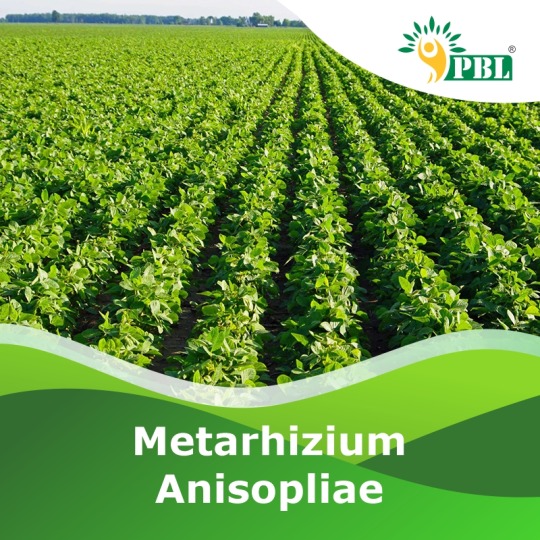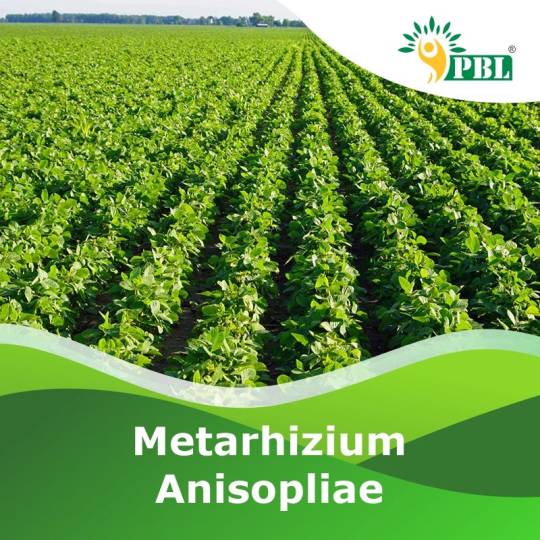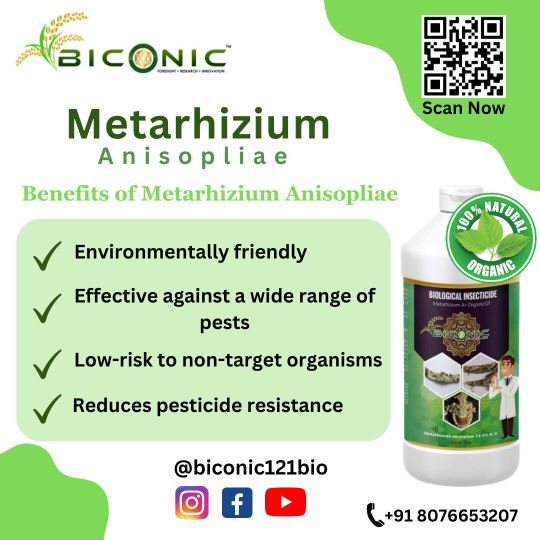#metarhizium anisopliae
Explore tagged Tumblr posts
Text
Why Does Bio-Fungus Make Your Farm Yield Productive?
Your farm cannot perform outstanding if you do not implement organic and innovative bio-fungus in your farm areas. It is very important for us to understand the overwhelming value of such types of bio-ingredients to improve the productivity of our farmlands.
Bio-fungus have the capability to resolve many issues on one hand and enhance the productivity and efficiency of your agricultural areas with an exponential level.
They form symbiotic relationships and reduce the possibilities of causing many diseases. In this way, biofungus like metarhizium anisopliae play a strong contribution towards the growth of the plant, but how, see the descriptions of pointers.

Improved Nutrient Uptake
Bio-fungus, such as mycorrhizal fungi and Paecilomyces Lilacinus, form robust symbiotic relationships with plant roots. It happens when they extend their mycelial network into the soil, meaning development of the effective area of the root.
The enhanced root system elevates the ability of plants to consume essential ingredients like water and nutrients, alongwith powerful elements, such as phosphorus, nitrogen, and micronutrients.
As a result, plants would become more efficient and capable to leverage such available nutrients and use them for better growth and higher yields of plant or crop.
Enhanced Water Absorption
Bio-fungus or mycorrhizal fungi play a key part in the access increment of the plant to soil moisture by effectively enhancing the reach of the root system. This property proves very valuable during periods of drought or water stress, as it enables plants to streamline optimal hydration levels and mitigates water-related stress. Ultimately, promoting the crop yields.
Disease Resistance
As bio-fungus and soil-borne pathogens reside in the same region in the root, they fight against harmful microorganisms for nutrients and space.
Bio-fungus secrete antimicrobial compounds to improve the defense mechanisms of the plant in order to make them less susceptible to diseases, leading in healthier crops and higher yields.
0 notes
Text
Metarhizium anisopliae stands out as a distinctive biological insecticide with entomopathogenic attributes. This fungus induces muscardine disease in a wide spectrum of insects, including various bugs, weevils, and hoppers. Upon encountering a host's exoskeleton, Metarhizium anisopliae spores swiftly germinate and propagate within the insect. Inside the insect's body, toxin production commences, initiating degradation of proteins. The ensuing impact comprises chemical, mechanical, water, and nutrient-related effects, culminating in the insect's demise. Read more
#metarhizium anisopliae#metarhizium anisopliae biopesticide#metarhizium anisopliae manufacturer#metarhizium anisopliae exporter
0 notes
Text
Những Mẹo Diệt Mối Tận Gốc Tại Nhà Hiệu Quả Nhất Năm 2025
Mối là một trong những loại côn trùng phổ biến và gây nhiều thiệt hại cho các kết cấu bằng gỗ và các công trình xây dựng tại gia đình chúng ta.
Tuy nhiên, với sự phát triển của khoa học và công nghệ, việc diệt trừ mối tận gốc tại nhà đã trở nên dễ dàng và hiệu quả hơn bao giờ hết.
Dưới đây là 12 cách diệt mối tận gốc tại nhà, hiệu quả nhất năm 2025:
Sử dụng vi sinh vật diệt mối:
Các loại vi sinh vật như Bacillus thuringiensis, Metarhizium anisopliae và Beauveria bassiana có thể được sử dụng để diệt trừ mối một cách an toàn và hiệu quả.
Áp dụng công nghệ nhiệt độ cao:
Sử dụng máy sưởi hoặc hơi nước nóng để xử lý các khu vực bị mối tấn công, nhiệt độ từ 50°C trở lên có thể giết chết mối và trứng của chúng.
Lắp đặt rào chắn ngăn mối:
Sử dụng các vật liệu như bê tông, kim loại hoặc nhựa để xây dựng các rào chắn ngăn mối xâm nhập vào nhà.
Sử dụng các loại thuốc trừ mối:

0 notes
Link
1 note
·
View note
Text
Les espèces invasives et la biodiversité : Fourmi de feu
See on Scoop.it - Les Colocs du jardin
L'IBPS (plate-forme intergouvernementale sur la biodiversité - équivalent du GIEC) vient de publier un rapport sur ce sujet et ils estiment le coût à près de 400 milliards par an. "La petite fourmi de feu provoque des dégâts sur les infrastuctures et les réseaux électriques. Elle mord aussi plus de 100 000 américains, causant la mort de près d'une centaine d'entre eux." Franck Courchamp d'Orsay a participé à cette étude. (Mouterde 2023)."
Alain Lenoir mis à jour 24-Jan-2024 "Des essais de lutte biologique sont menés depuis des années contre Solenopsis invicta par des champignons, des parasitoïdes (Eucharitidae, mouches phorides) qui n’ont pas suivi lors de la migration. On peut infecter les fourmis avec le champignon pathogène Metarhizium anisopliae, mais elles boivent plus de quinine (self medication), reçoivent plus de trophallaxies (Qiu et al. 2016). C’est de l’immunité sociale, donc la lutte est difficile. Pseudacteon tricuspis et P. curvatus sont des mouches phorides parasitoïdes d'Amérique du Sud qui pourraient limiter la prolifération des fourmis de feu, mais leur effet est minime (Valles et al. 2010; Porter and Calcaterra 2013). Pierre Jolivet écrivait déjà en 1986 que la lutte avec les parasitoïdes « semble sans espoir » (Jolivet 1986, p. 187). Les fourmis de feu provoquent des dégâts importants aux cultures (soja, citronniers) mais sont de bonnes prédatrices (en Louisiane on ne traite pas contre cette fourmi dans les plantations de canne à sucre). Aux États-Unis, les fourmis de feu invasives consomment les oeufs et les juvéniles de beaucoup de reptiles, ce qui les rend vulnérables (Burnouf 2020). La RIFA est arrivée en Australie en 2001 par le port de Brisbane et tend à envahir tout le continent. Des associations voudraient qu'on multiplie les lieux où l'on va tenter de l'éradiquer (Woessner 2016, L'Express 2016). Cela pourrait coûter des centaines de millions de dollars, mais je suis certain que cela ne fera que retarder l'invasion, enrichir les marchands de pesticides et polluer encore plus le pays !!! Dans le Queensland il y a un énorme programme d'éradication de cette fourmi. On a même dressé des chiens pour trouver les fourmis. Les insecticides sont l'hydraméthylnone (toxique pour les poissons et les rats), le méthoprène (Perturbateur Endocrinien) ou le pyriproxyfène (toxique pour les animaux aquatiques), tous produits très dangereux !"
Biosecurity Act 2014 | National Fire Ant Eradication Program https://www.fireants.org.au/about-us/biosecurity-act-2014
Bernadette Cassel's insight:
Actualité en relation
L’armée australienne a un nouvel ennemi : les fourmis de feu - De www.courrierinternational.com - 27 juin, 19:59
0 notes
Text
The Role of Biological Control Agents in Pest Eradication Programs

In the ongoing battle against pests, biological control agents emerge as unsung heroes, offering a sustainable and environmentally friendly approach to pest eradication. In this article, we'll explore the vital role of biological control agents in pest eradication programs, shedding light on their effectiveness, benefits, and applications in agriculture and beyond.
1. Understanding Biological Control Agents
Biological control agents, also known as natural enemies or biocontrol agents, are organisms that control pest populations through predation, parasitism, herbivory, or other natural mechanisms. These agents include predators, parasitoids, pathogens, and herbivores that feed on or otherwise target pest species, helping regulate pest populations and reduce crop damage.
2. Predatory Biological Control Agents
Predatory biological control agents are organisms that feed on pest species, reducing their populations and suppressing pest outbreaks. Examples of predatory organisms include:
Ladybugs: Ladybugs, also known as ladybirds or lady beetles, are voracious predators of aphids, scale insects, and other soft-bodied pests. Their presence in agricultural fields helps control aphid populations and prevent crop damage.
Lacewings: Lacewings are delicate insects with intricate lace-like wings and voracious appetites for aphids, caterpillars, and other soft-bodied pests. They are valued biological control agents in greenhouse and field crops.
Praying Mantises: Praying mantises are ambush predators that feed on a wide range of insect prey, including flies, crickets, and moths. Their predatory behavior makes them effective allies in pest management programs.
3. Parasitoid Biological Control Agents
Parasitoid biological control agents are organisms that lay their eggs inside or on the bodies of pest species, leading to the eventual death of the host. Examples of parasitoids include:
Braconid Wasps: Braconid wasps are parasitoids that target a variety of pest species, including caterpillars, aphids, and beetles. They lay their eggs inside the bodies of their hosts, where the developing larvae feed and eventually kill the host.
Tachinid Flies: Tachinid flies are parasitoids that target a wide range of pest insects, including caterpillars, beetles, and true bugs. They lay their eggs on or near the bodies of their hosts, and the developing larvae feed internally, eventually killing the host.
4. Pathogenic Biological Control Agents
Pathogenic biological control agents are organisms that infect and kill pest species through disease. Examples of pathogenic agents include:
Entomopathogenic Fungi: Entomopathogenic fungi such as Beauveria bassiana and Metarhizium anisopliae are natural pathogens of insects. These fungi infect pests through contact, penetrating their exoskeletons and causing death through fungal colonization.
Nematodes: Certain species of entomopathogenic nematodes are effective biological control agents against soil-dwelling pests such as grubs, weevils, and larvae. These nematodes enter the bodies of their hosts and release bacteria that kill the host insect.
5. Benefits of Biological Control Agents
Biological control agents offer several advantages over chemical pesticides in pest eradication programs, including:
Environmental Safety: Biological control agents are typically target-specific and pose minimal risk to non-target organisms, beneficial insects, and the environment.
Sustainable Pest Management: Biological control agents provide long-term pest control solutions that are compatible with organic farming practices and integrated pest management (IPM) approaches.
Reduced Pesticide Reliance: By reducing reliance on chemical pesticides, biological control agents help minimize pesticide residues in food, soil, and water, promoting human health and environmental sustainability.
Summary
Biological control agents play a crucial role in pest eradication programs, offering sustainable, environmentally friendly solutions to pest management challenges. By harnessing the power of predators, parasitoids, pathogens, and other natural enemies, farmers can effectively control pest populations while minimizing environmental impact and promoting agricultural sustainability. Let us continue to explore and implement biological control strategies, ensuring a healthier, more resilient agricultural ecosystem for generations to come.
Contact Us,
Name: Mana Tahuna
Address: 5 Sutherland Lane, Frankton, Queenstown 9300, New Zealand
Phone: +64 21 860 393
1 note
·
View note
Text
Get Today's Best Metarhizium Anisopliae biopesticide at Peptech Biosciences Ltd
Metarhizium Anisopliae stands out as a distinctive biological insecticide. This entomopathogenic fungus induces muscardine disease in a variety of insects such as bugs, weevils, and hoppers. Upon contact with a host’s cuticle, M. anisopliae spores rapidly grow and multiply within the insect. Once inside, the fungus releases toxins, initiating protein degradation. The insect succumbs to a combination of chemical, mechanical, water loss, and nutrient loss effects. The speed of the insect’s demise hinges on factors like the spore count, the insect’s age, susceptibility, and prevailing environmental conditions.

0 notes
Text
Embracing Environmentally Friendly Solutions For Kissimmee Termite Treatment

Pests are well known for causing substantial damages to wood frameworks, posing a considerable danger to homes as well as services. Typical pest control procedures frequently involve using chemical pesticides, which can possess unsafe impacts on the atmosphere, human wellness, and also non-target types. As awareness of environmental concerns expands, there is a growing necessity for ecological options in termite treatment.
Organic Control
One appealing ecological method to Kissimmee Termite Treatment is natural control. This includes using organic predators, bloodsuckers, or even virus to control termite populaces. Nematodes, tiny earthworms that are harmless to people as well as creatures, may be actually offered in to the soil to target termite colonies. Beneficial fungis, such as Metarhizium anisopliae, have actually additionally revealed assurance responsible termite attacks without damaging the atmosphere.
Agricultural Extracts
Plant-derived compounds can be reliable options to chemical pesticides. Vital oils removed from plants like natures neem, clove, and also eucalyptus have actually illustrated insecticidal properties. These herb extracts disrupt the termite's capacity to supply as well as replicate, supplying an organic as well as non-toxic solution. In addition, these extracts are actually naturally degradable and also have very little effect on the environment.
Baiting Systems
Enticing devices are actually one more green system for termite treatment Kissimmee. Rather than prevalent chemical uses, lure stations are purposefully positioned around the residential or commercial property. These terminals consist of cellulose component infused with a slow-acting, termite-specific toxin. Pests feed on the lure as well as allotment it along with the nest, inevitably resulting in its own removal. This targeted technique minimizes making use of chemicals and also reduces the effect on non-target microorganisms.
youtube
Physical Barriers
Setting up bodily barricades is actually a preventive green solution versus pests. Stainless steel screen, gravel, or even other products can be actually made use of to create obstacles that termites can not permeate. These barricades are durable and do certainly not include using chemicals. Bodily barricades also have the perk of being multiple-use as well as may be combined right into the building and construction or landscaping style of a property.
Educational and Preventive Measures
Promoting awareness regarding termite avoidance and also early detection is an important aspect of green Kissimmee termite treatment. Urging proper home upkeep, regular assessments, and resolving dampness concerns may aid protect against termite invasions from the beginning. Through educating individuals about termite habits as well as routines, neighborhoods can easily lower the reliance on chemical therapies and use a more lasting technique to termite control.
Outcome
As the globe comes to grips with environmental concerns, it ends up being important to seek environment-friendly services in every facet of lifestyle, consisting of parasite control. Taking on alternate methods for termite treatment not simply shields the environment however also makes sure the wellness and also well-being of citizens. Biological control, organic extracts, baiting units, bodily barricades, and education and learning are actually all realistic choices that contribute to a much more sustainable and eco-conscious technique to termite monitoring. Through welcoming these options, our company can protect our homes without endangering the health of our world. As innovation and also research study progress, it is very likely that even additional innovative as well as maintainable methods will certainly emerge, even more minimizing the ecological footprint of termite control practices.
All American Pest Control
1101 Miranda Lane, Suite 131
Kissimmee, FL 34741
(321) 337-0919
Kissimmee Termite Treatment
0 notes
Text
Metarhizium anisopliae: Nature's Precision in Eco-Friendly Pest Control
Metarhizium anisopliae is a naturally occurring fungus widely used as a biopesticide for insect pest control. As an entomopathogenic fungus, it infects a broad spectrum of pests, offering an eco-friendly alternative to chemical pesticides. Its mode of action involves penetrating the insect cuticle, releasing toxins, and causing pest mortality. This biopesticide is environmentally safe, compatible with Integrated Pest Management (IPM) practices, and available in various commercial formulations for soil or foliar application. Ongoing research continues to optimize its effectiveness and explore new applications. For cutting-edge biopesticide solutions, explore Peptech’s innovative products at Peptech’s Website.

0 notes
Text
BENEFITS OF METARHIZIUM ANISOPLIAE | MANUFACTURER & EXPORTER - PEPTECH BIO
Metarhizium anisopliae, a naturally occurring entomopathogenic fungus, offers numerous advantages for sustainable and eco-friendly agriculture. Acting as a biological pest control agent, it provides targeted specificity against certain insect pests while preserving the environment. Its benefits include:
Biological Pest Control: Natural control agent against insect pests.
Targeted Specificity: Selectively targets pests without harming beneficial organisms.
Sustainable Agriculture: Aligns with principles of eco-friendly and balanced farming.
Environmentally Friendly: Minimizes harm to non-target organisms and ecosystems.

0 notes
Text
The Mighty Metarhizium Anisopliae: Unleashing Nature's Biocontrol Agent
Metarhizium anisopliae is a species of entomopathogenic fungus that is widely used in agriculture and pest control. Here are some of the key uses of Metarhizium anisopliae.

Biological Pest Control
Metarhizium anisopliae is primarily used as a biocontrol agent for managing insect pests. The fungus infects and kills a wide range of insects and other arthropods, including beetles, termites, grasshoppers, and mosquitoes. It can be applied as a spray, dust, or granule, targeting specific pest species while minimizing harm to non-target organisms.
Agricultural Applications
Metarhizium anisopliae is employed in agriculture to combat pests that damage crops. By using this fungal biopesticide, farmers can reduce reliance on chemical insecticides and promote sustainable pest management practices, and the killing of nematodes like Paecilomyces Lilacinus.
Vector Control
The fungus is also used to control disease-transmitting vectors such as mosquitoes and ticks. Metarhizium anisopliae can be applied in mosquito breeding sites or as a barrier treatment to prevent mosquito populations from spreading diseases like malaria, dengue, Zika, and others. It offers an environmentally friendly alternative to chemical insecticides.
Forest Pest Mangement
Forests face various insect pests that can cause significant damage to trees. Metarhizium anisopliae has been used to control pests like bark beetles, leaf-feeding caterpillars, and wood borers. By introducing the fungus into affected areas, it can help manage pest populations and protect forest resources.
Veterinary Applications
Metarhizium anisopliae is utilized in veterinary medicine to control ectoparasites infesting livestock and companion animals. It can be used to manage pests such as fleas, ticks, mites, and lice. The application of the fungus as a biocontrol agent reduces the reliance on chemical pesticides in animal husbandry.
Environmental Applications
Apart from its role in pest control, Metarhizium anisopliae has potential applications in environmental remediation. The fungus has been studied for its ability to degrade pollutants and contaminants, including organic pollutants in soil and water. This property opens up possibilities for using the fungus in bioremediation processes.
0 notes
Text
Fungal insecticides are the most widely used type of microbial insecticides except bacterial insecticides. At present, the active ingredients of fungal insecticides mainly include Beauveria bassiana, Metarhizium anisopliae and Paecilomyces lilacinus (Thom.) Samson, etc. These fungi are highly infective, The insecticidal effect can be achieved through mycelium invasion of insects, enzymatic…
View On WordPress
0 notes
Text

"Metarhizium anisopliae: The fungus with a mission to control pests." . . Contact Us:- +91 8076653207
#biofertilizers#organic#fertilizers#agriculture#organicfarming#fertilizer#organicfertilizers#organicagriculture#organicproducts#organico#organicgrowing#farming#soil#organicgardening#sinquimicos#photodujour
0 notes
Link
1 note
·
View note

